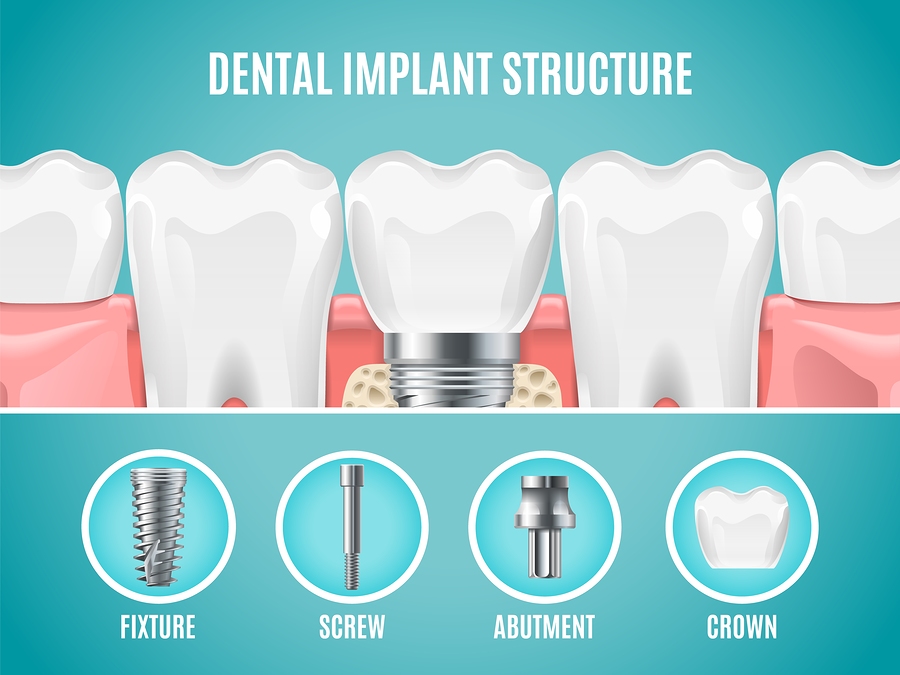The 10-Second Trick For Dental Sense
The 10-Second Trick For Dental Sense
Blog Article
Our Dental Sense PDFs
Table of ContentsThe Best Strategy To Use For Dental Sense7 Easy Facts About Dental Sense ShownEverything about Dental SenseAn Unbiased View of Dental Sense
are medical gadgets operatively implanted right into the jaw to bring back an individual's capability to chew or their appearance. They offer assistance for synthetic (fake) teeth, such as crowns, bridges, or dentures. When a tooth is lost due to injury or illness, a person can experience problems such as quick bone loss, malfunctioning speech, or adjustments to eating patterns that lead to pain.Dental implant systems contain an oral implant body and oral implant joint and might also include a joint addiction screw. Root canal procedure. The oral implant body is operatively inserted in the jawbone in location of the tooth's root. The dental implant joint is usually attached to the implant body by the abutment addiction screw and prolongs through gum tissues into the mouth to sustain the affixed fabricated teeth
(https://ameblo.jp/dentalsense1/entry-12882048969.html)Framework of The Oral Implant System selecting dental implants, talk with your oral provider regarding the potential benefits and threats, and whether you are a candidate for the procedure. Points to take into consideration: Your overall wellness is an important consider identifying whether you are a great candidate for dental implants, how much time it will certainly take to recover, and the length of time the dental implant may remain in location.
Smoking may impact the healing procedure and reduce the long-term success of the dental implant. The recovery procedure for the implant body might take several months or longer, throughout which time you usually have a short-term abutment instead of the tooth. the dental implant treatment: Thoroughly follow the oral hygiene instructions provided to you by your oral copyright.
Dental Sense for Dummies
Implant failure can result in the need for another operation to deal with or change the dental implant system. Restores the capability to eat Recovers aesthetic appearance Assists keep the jawbone from reducing because of bone loss Maintains the health and wellness of the surrounding bone and gum tissues Aids keep surrounding (neighboring) teeth secure Enhances high quality of life Damages to bordering all-natural teeth during dental implant positioning Injury to the surrounding cells during surgical procedure, such as sinus opening Injury throughout surgical procedure (for example, fracture of bordering jawbone) Inadequate feature, such as feeling like the teeth do not bite with each other normally A feeling that the tooth is loosened or twisting in position resulting visit from an abutment screw loosening Implant body failure (looseness of the dental implant body) because of systemic infection, which might be more probable in clients with uncontrolled diabetics issues as a result of local infection in bone and periodontals sustaining the implant body as a result of delayed recovery, which might be much more most likely in clients that smoke Problem cleaning the gums around the dental implant, causing poor dental hygiene Unattended gum disease Post-surgical feeling numb due to nerve impingement or damage Constantly notify wellness care providers and imaging professionals that you have oral implants prior to any kind of magnetic resonance imaging (MRI) or x-ray treatments.
FDA is not familiar with any type of adverse events reported for MRI or x-ray treatments with dental implants. Dental implants systems are typically made of materials that comply with international consensus requirements of the International Company for Standardization (ISO) or ASTM International. These standards have details of what makes a safe material.

An oral implant is a framework that replaces a missing tooth. With screw-like devices, the specialist inserts a dental implant into the jawbone, and it acts as a support for an artificial tooth, called a crown.
Unknown Facts About Dental Sense
Some people are not eligible for oral implant surgical treatment. It is for dental specialists to operate people with: severe illnessuncontrollable metabolic diseasebone or soft cells condition or infectionIf these problems are resolved, an individual can have the surgical treatment. In, dental specialists avoid operating individuals with: If people with any of the above undergo oral implant surgery, there is a greater threat of the implant falling short.

Oral implant surgical procedure is a tailored procedure. Offer you time to recover. Attach the message and final crown, bridge or denture.
Next off, your specialist will very carefully position the dental implant into your jaw. Your doctor will rearrange your periodontals and close the cut with stitches. If your implant is near the front of your mouth, your dental expert will certainly make a temporary tooth for you to wear up until you heal. In this way, you will not have a void in your smile while you recover.
How Dental Sense can Save You Time, Stress, and Money.
Your service provider can inform you what to anticipate in your situation. Throughout the healing stage, your jawbone needs to fuse to the oral implant. This procedure, called osseointegration, is critical for security and long-term success. This process can take anywhere from three to 9 months. Sometimes, it might take much longer.
When your dental implant heals, your dental practitioner can attach the joint (little port article) and your final repair (crown, bridge or denture). This generally takes concerning one hour to complete and might call for a second minor surgical treatment. You shouldn't feel any type of discomfort during your oral implant treatment due to the fact that your copyright will certainly utilize drug to numb your gums.
Report this page